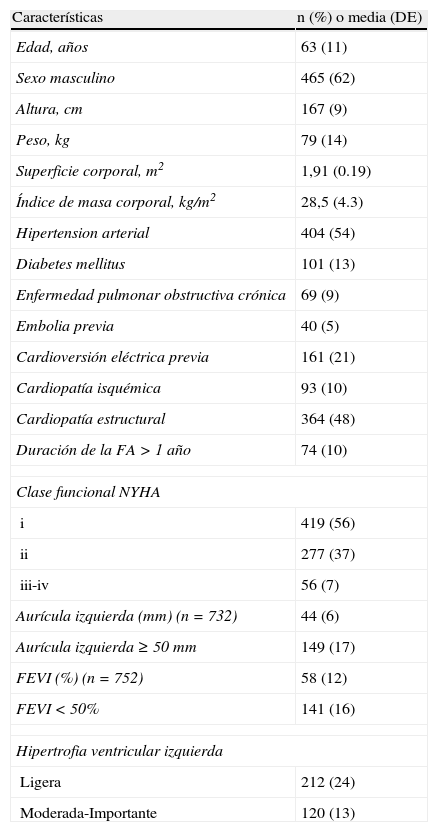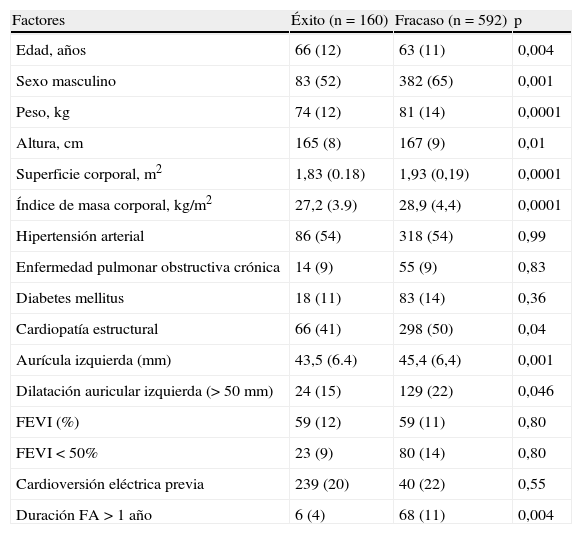Algunos pacientes con fibrilación auricular persistente que se tratan con antiarrítmicos al indicarse una cardioversión eléctrica revierten a ritmo sinusal antes de la misma. El conocimiento de los factores que predicen esta situación puede ser de utilidad clínica.
MetodologíaSe analizaron los datos de los pacientes del REgistro sobre la cardioVERSión en España (REVERSE) que recibieron fármacos antiarrítmicos con capacidad cardioversora previamente a la cardioversión eléctrica. Se estudió mediante regresión logística los factores predictivos de reversión a ritmo sinusal precardioversión.
ResultadosDe los 752 pacientes tratados con antiarrítmicos, 160 (21%) revirtieron a ritmo sinusal antes de la cardioversión eléctrica. El fármaco más utilizado fue amiodarona (82%), que consiguió una reversión a ritmo sinusal superior al resto de los antiarrítmicos, aunque sin alcanzar diferencias significativas (amiodarona 22% frente a otros antiarrítmicos 17%; p=0,22). La ausencia de obesidad (índice de masa corporal<30kg/m2) (odds ratio [OR] 1,9; p=0,006), la duración de la fibrilación auricular<1 año (OR 3,4; p=0,02) y la ausencia de cardiopatía estructural (OR 1,59; p=0.01) se identificaron como variables independientes predictoras de reversión a ritmo sinusal. Entre los pacientes tratados con amiodarona que cumplían los 3 criterios, un 31% revirtieron a ritmo sinusal.
ConclusiónEn pacientes con fibrilación auricular persistente tratados con antiarrítmicos se debe tener cuenta que la ausencia de obesidad, la duración de la fibrilación auricular<1 año y la ausencia de cardiopatía estructural constituyen factores clínicos que pueden predecir la reversión a ritmo sinusal antes de la cardioversión eléctrica.
Some patients with persistent atrial fibrillation treated pharmacologically revert to sinus rhythm prior to electrical cardioversion. Knowledge of factors predicting this effect may be clinically useful.
MethodologyData were obtained from patients enrolled in the study REgistro sobre la cardioVERSión en España (REVERSE) and treated with antiarrhythmic drugs that potentially may cause pharmacological reversal. We analized by means of logistic regression predictive factors related to reversion to sinus rhythm precardioversion.
ResultsOf the 752 patients treated with antiarrhythmic drugs, 160 (21%) reverted to sinus rhythm without electrical cardioversion. Amiodarone was the most widely used active compound (82%) and apparently the most effective. However, differences with other antiarrhythmic drugs were not significant (amiodarone 22% versus other antiarrhythmic drugs 17%, P=.22). Lack of obesity (body mass index<30kg/m2) (odds ratio [OR]=1.9; P=.006), duration of atrial fibrillation<1 year (OR 3.4; P=.02) and the absence of structural heart disease (OR 1,59; P=.01) were identified as independent variables with predictive value of pharmacological reversal to sinus rhythm. Among patients treated with amiodarone who met these criteria, the frequency of successful treatment increased up to 31%.
ConclusionIn patients with persistent atrial fibrillation treated with anti-arrhythmic drugs, lack of obesity, duration of atrial fibrillation<1 year and the absence of structural heart disease are predictors of reversion to sinus rhythm before electrical cardioversion.
Artículo
Comprando el artículo el PDF del mismo podrá ser descargado
Precio 19,34 €
Comprar ahora








